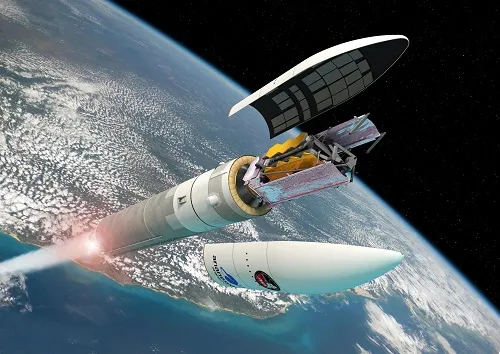James Webb Telescope Launches on Historic Search for Alien Life

NASA’s James Webb Telescope has successfully launched into space as it begins its mission to look back into the early cosmos and look for alien life.

Illustrative image of the Ariane-5 rocket exiting the Earth’s atmosphere and ready to eject the James Webb Space Telescope.
Three decades into the construction, the $10 billion probe took off in spectacular fashion on an Ariane rocket from French Guiana. NASA scientists now face “two weeks of terror” as they cross their fingers and hope that everything goes according to plan. This is because the James Webb telescope is much larger than any payload any rocket has ever launched.
The James Webb telescope was designed to detect light from the youngest stars in the Universe using its 21-foot (6.5-meter) wide golden mirror.
NASA had to get around this problem by turning the telescope into the most complex and expensive piece of origami in the world.
The telescope was launched folded inside Ariane 5’s payload fairing, after which it will undergo a relentless unwinding procedure.
Once unrolled, Dr. Megan Argo, vice president of the Royal Astronomical Society, said it will be almost as big as a tennis court.
Webb’s goal will be to try to show the first stars and galaxies to shine in the Universe.
It will also have the power to probe the atmosphere of distant planets for gases that could suggest the presence of life.
NASA Administrator Bill Nelson told the BBC:
“Webb is an extraordinary mission.
It’s a shining example of what we can accomplish when we dream big. We always knew that this project would be a risky undertaking. But, of course, when you want a big reward, you usually have to take a big risk.”
At the heart of its capabilities is the 6.5 meter wide golden mirror. It will work alongside four super-sensitive instruments and should allow Webb to detect light from the first stars.
NASA Senior Project Scientist John Mather added:
“They will just be little red spots.
We think there should be stars, galaxies, or black holes perhaps starting 100 million years after the Big Bang. There won’t be many of them to find at that time, but the Webb telescope can see them if they are there and we were lucky.”
The JWST has been in the works since Hubble’s April 1990 launch and was originally planned to be built and ready to fly as early as 2007.
The project has suffered many delays over the years, including a recent decision to push the release date back to Christmas Day.
(Source)




